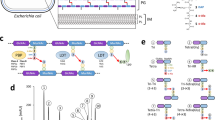Summary
Colonies of Escherichia coli or Salmonella typhimurium that form colicin I often produce larger inhibition zones when the sex factor of their plasmid is de-repressed. In liquid culture, virtually all colicin I is cell-bound; colicin titres with de-repressed factors are only slightly greater than with the wild type; no more covalently-closed plasmid DNA is present; and no more plasmid-determined enzyme is formed. The large zones are therefore unlikely to reflect an increase in the number of plasmid genomes per cell. De-repressed factors make the cells susceptible to lytic agents, indicating a change in the cell wall, which may result in greater release of cell-bound colicin and so increase the size of inhibition zones.
Salmonella typhimurium LT2 carries a plasmid of unknown function.
Similar content being viewed by others
References
Arima, K., Katoh, Y., Beppu, T.: Studies on colicin B. Mode of action and new extraction from cells. Agr. biol. Chem. 32, 170 (1968).
Cooke, M., Meynell, E., Lawn, A. M.: Mutant Hfr strains defective in transfer: restoration by F-like and I-like de-repressed R factors. Genet. Res., in press (1970).
Edwards, S., Meynell, G. G.: General method for isolating de-repressed bacterial sex factors. Nature (Lond.) 219, 869 (1968).
Egawa, R., Hirota, Y.: Inhibition of fertility by multiple drug-resistance factor in Escherichia coli K12. Jap. J. Genet. 37, 66 (1962).
Goldschmidt, M. C., Goldschmidt, E. P., Wyss, O.: Differences in toxicity of EDTA and tris among mating types of Escherichia coli. Canad. J. Microbiol. 13, 140 (1967).
—, Wyss, O.: The role of tris in EDTA toxicity and lysozyme lysis. J. gen. Microbiol. 47, 421 (1967).
Hayes, W.: The mechanism of genetic recombination in Escherichia coli. Cold Spr. Harb. Symp. quant. Biol. 18, 75 (1953).
Inuzuka, N., Nakamura, S., Inzuzuka, M., Tomoeda, M.: Specific action of sodium dodecyl sulfate on the sex factor of Escherichia coli K-12 Hfr strains. J. Bact. 100, 827 (1969).
Jacob, F., Siminovitch, L., Wollman, E. L.: Sur la biosynthèse d'une colicine et sur son mode d'action. Ann. Inst. Pasteur 83, 295 (1952).
McEvoy-Bowe, E.: Modification of the Scott method for the determination of indole. Analyst 88, 893 (1963).
Meynell, E., Datta, N.: Mutant drug resistance factors of high transmissibility. Nature (Lond.) 214, 885 (1967).
—, Meynell, G. G., Datta, N.: Phylogenetic relationships of drug-resistance factors and other transmissible bacterial plasmids. Bact. Rev. 32, 55 (1968).
Meynell, G. G., Aufreiter, E.: Functional independence of F and I sex pili. Nature (Lond.) 223, 1069 (1969).
—, Lawn, A. M.: Sex pili and common pili in the conjugational transfer of colicin factor Ib by Salmonella typhimurium. Genet. Res. 9, 359 (1967a).
—: The sex factor of colicin factor Ela. Genet. Res. 10, 323 (1967b).
—: Filamentous phages specific for the I sex factor. Nature (Lond.) 217, 1184 (1968).
—, Meynell, E.: Theory and practice in experimental bacteriology, 2nd ed. Cambridge: University Press 1970.
Radloff, R., Bauer, W., Vinograd, J.: A dye-buoyant-density method for the detection and isolation of closed circular duplex DNA: the closed circular DNA in Hela cells. Proc. nat Acad. Sci. (Wash.) 57, 1514 (1967).
Smith, H. W., Halls, S.: The transmissible nature of the genetic factor in Escherichia coli that controls haemolysin production. J. gen. Microbiol. 47, 153 (1967).
—: The transmissible nature of the genetic factor in Escherichia coli that controls enterotoxin production. J. gen. Microbiol. 52, 319 (1968).
Smith, O. H., Yanofsky, C.: Enzymes involved in the biosynthesis of tryptophan. Meth. Enzymol. 5, 794 (1962).
Tomoeda, M., Inuzuka, M., Kubo, N., Nakamuara, S.: Effective elimination of drug resistance and sex factors in Escherichia coli by sodium dodecyl sulfate. J. Bact. 95, 1078 (1968).
Zinder, N. D.: Lysogenization and superifection immunity in Salmonella. Virology 5, 291 (1958).
Author information
Authors and Affiliations
Additional information
Communicated by R. H. Pritchard
Rights and permissions
About this article
Cite this article
Dowman, J.E., Meynell, G.G. Pleiotropic effects of de-repressed bacterial sex factors on colicinogeny and cell wall structure. Molec. Gen. Genetics 109, 57–68 (1970). https://doi.org/10.1007/BF00334046
Received:
Issue Date:
DOI: https://doi.org/10.1007/BF00334046




